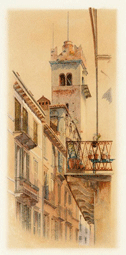The Tower of Can Signorio, from the Corso Cavour, Verona
Frank Randal (1852-1917). Watercolour on paper, 1884
WorkThis drawing depicts the 'Torre del Gardello' or watchtower of the Palazzo del Comune, one of the administrative palaces of Verona. The tower dates from the 1370s. Its V-shaped crenellations indicate that it was built by the Scaglieri family, who ruled Verona between the 1200s and 1400s.
ArtistFrank Randal (1852-1917) was born in Paddington, London, to Charles Hayter Randal and Frances (née Arnold). Little is known of Randal, but Ruskin commissioned more works from him than any other artist in the Ruskin Collection. He caught the attention of Ruskin in 1881. He started to commission work from Randal, and this continued until 1887. Over this time, he produced at least 137 drawings and watercolours for the Guild. Randal later worked for Sir Sydney Cockerell, painting architectural records for the Society for the Preservation of Pictorial Records of Ancient Works of Art and painting commissions. This included a number for a prominent Sheffield art collector, George Parkes Wall, who was founder of the Pluto Steelworks. Randal had a brother Charles (described in the 1881 census as a photographer, and in the 1891 census as an artist and sculptor), and a sister, Fanny Scott Randal. A sketch of W. G. Collingwood, Ruskin and Randal was drawn on a letter that Charles sent to Fanny. Collection of the Guild of St George, Museums Sheffield
-----
[The information concerning Randal's family connections was kindly supplied by Philippa Robertson of Morrinsville, New Zealand, the great great grandaughter of Randal's uncle, John Lawrence Randal, an architect at Shrewsbury.]----- Ruskin on VeronaRuskin outlined his feelings about Verona in A Joy Forever (1857-1880):'if I were asked to lay my finger, in a map of the world, on the spot of the world's surface which contained at this moment the most singular concentration of art-teaching and art-treasure, I should lay it on the name of the town of Verona. [...] Verona possesses [...] perfect examples of the great twelfth-century Lombardic architecture, which was the root of all the medieval art of Italy, without which no Giottos, no Angelicos, no Raphaels would have been possible: it contains that architecture, not in rude forms, but in the most perfect and loveliest types it ever attained -- contains those, not in ruins, nor in altered and hardly decipherable fragments, but in churches perfect from porch to apse, with all their carving fresh, their pillars firm, their joints unloosened.' (Works, 16, p. 66). |



















